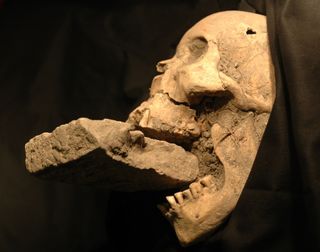
The mystery behind several "vampire" burials in Poland has been solved.
People who were buried with sickles (curved, sharp farming knives) around their necks, or rocks at their jaws, to prevent their corpses from reanimating were natives to the area in which they were buried, according to a new study.
The fact that all the people buried as vampires were local suggests they may have been felled by a cholera epidemic that swept through the region, said study co-author Lesley Gregoricka, a bioarchaeologist at the University of South Alabama. [7 Strange Ways Humans Act Like Vampires]
Tales of vampires
Tales of the dead coming back to life have truly ancient roots, going back to the ancient Egyptians, Greeks, Babylonians and beyond, said study co-author Tracy Betsinger, a bioarchaeologist at the State University of New York at Oneonta.
For all these stories of the dead coming back to life, "the word collectively used is a 'revenance,'" Betsinger told Live Science.
Tales of vampires have circulated in Eastern Europe since at least the 11th century, and newspaper accounts have described alleged vampires since the 17th century. For instance, in 1725, an Austrian official recounted the story of Serbian peasant Petar Blagojevic, who was said to have killed nine villagers in his area before people staked him through his heart. Vampire lore at this time didn't require blood sucking as an integral feature; instead, the undead could slay living people with just a glance.
Sign up for the Live Science daily newsletter now
Get the world’s most fascinating discoveries delivered straight to your inbox.
In ancient lore, a person was at risk of becoming a vampire after death if he or she was unbaptized, died a violent death, was the first one killed in an epidemic or was an outsider from another local, Gregoricka said.
Notions that vampires drank blood may have arisen during plagues and epidemics, when corpses would often lie exposed and decomposing for long periods of time.
"People were up close and personal with death at this point, but didn't have a good way to explain what was happening," Gregoricka told Live Science.
For instance, the body tends to bloat after death from bacterial-produced gases. This pressure in the lower body, in turn, forces blood up from the lungs, into the esophagus and then through the mouth, which may have led villagers to believe the corpse of a person who was waiflike and frail during life was fat from feasting on blood, she said.
Vampire burial
Gregoricka and her colleagues analyzed bone fragments from the Drawsko cemetery, a Polish site where vampire burials were found. The cemetery dates from the 17th to the 18th century, the researchers said. Some people at the site were buried with sickles under their necks or rocks under their jaws, to prevent them from reanimating. (The sickles were intended to decapitate the people if they tried to rise from the grave, while the rocks pinned their jaws shut so they weren't able to feed on the living, Gregoricka said.)
The researchers then took a closer look at 60 of the 333 burials from the site, six of which were "vampire" burials intended to prevent a corpse from reanimating. The team analyzed the ratio of strontium isotopes (versions of the atom with different numbers of neutrons) in the skeletons. Because each location has a unique ratio of these isotopes, and people's bodies naturally take the elements up from the environment, analyzing strontium isotope ratios can reveal where a person is from.
Contrary to the initial hypothesis that the "vampires" were immigrants, the team actually discovered that all of the vampires were locals.
Since none of the "vampires" showed signs of a violent death or severe trauma, the team speculates that the vampires were perhaps the first people felled in one of the cholera epidemics that swept the area during the time. People could die of cholera in days or even hours, Gregoricka said.
"If something kills you very quickly, it's not going to leave a mark on the bone," Gregoricka said.
As a follow-up, the researchers want to conduct more chemical analyses to see if they can learn more about these villagers. The findings were published today (Nov. 26) in the journal PLOS ONE.
Follow Tia Ghose on Twitter and Google+. Follow Live Science @livescience, Facebook & Google+. Originally published on Live Science.

Tia is the managing editor and was previously a senior writer for Live Science. Her work has appeared in Scientific American, Wired.com and other outlets. She holds a master's degree in bioengineering from the University of Washington, a graduate certificate in science writing from UC Santa Cruz and a bachelor's degree in mechanical engineering from the University of Texas at Austin. Tia was part of a team at the Milwaukee Journal Sentinel that published the Empty Cradles series on preterm births, which won multiple awards, including the 2012 Casey Medal for Meritorious Journalism.
Most Popular



